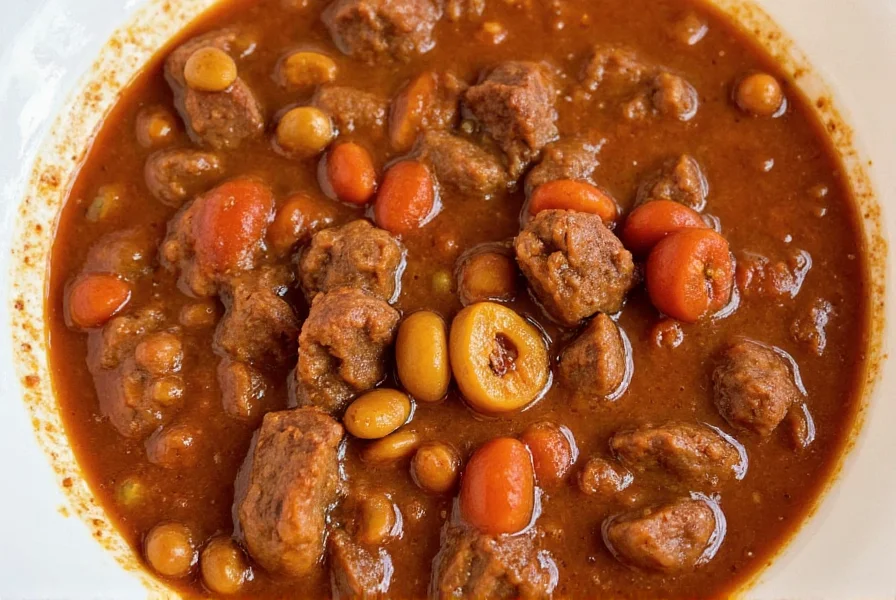The best steak chili recipe features cubed chuck roast simmered with fire-roasted tomatoes, kidney beans, and a balanced spice blend of chili powder, cumin, and smoked paprika for 2-3 hours. This hearty dish serves 6-8 people and requires 30 minutes prep time plus slow cooking for optimal tenderness. For authentic flavor, use dark beer instead of broth and finish with fresh lime juice.
Nothing beats a rich, meaty steak chili on a cold evening. Unlike traditional ground beef versions, this steak chili recipe showcases premium beef cuts transformed through slow cooking into fork-tender morsels swimming in a deeply flavorful broth. The magic happens when quality ingredients meet proper technique—browning the meat thoroughly, layering spices, and allowing ample simmering time for flavors to meld.
Why This Steak Chili Recipe Works
Most chili recipes settle for ground beef, but upgrading to steak creates a restaurant-quality dish with superior texture and beef flavor. The key is selecting the right cut and cooking method. Chuck roast contains ideal marbling that breaks down during slow cooking, while the addition of dark beer enhances umami notes without making the chili taste alcoholic.
Essential Ingredients for Steak Chili
Quality ingredients make the difference between ordinary and exceptional chili. Here's what you'll need:
| Ingredient | Quantity | Why It Matters |
|---|---|---|
| Boneless chuck roast | 2 lbs, 1-inch cubes | Rich marbling ensures tenderness after slow cooking |
| Fire-roasted tomatoes | 28 oz can | Adds depth and slight charred flavor |
| Dark beer | 12 oz | Enhances meatiness (substitute with beef broth) |
| Chipotle peppers in adobo | 2 peppers + 1 tbsp sauce | Provides smoky heat without overwhelming spice |
Step-by-Step Steak Chili Instructions
- Prep the steak: Pat 2 lbs chuck roast cubes completely dry with paper towels. Season generously with salt and pepper.
- Sear properly: Working in batches, brown meat on all sides in hot oil (425°F). This Maillard reaction creates complex flavors—don't rush this step.
- Build flavor base: Sauté 1 diced onion and 4 minced garlic cloves until translucent. Add 3 tbsp chili powder, 2 tsp cumin, 1 tsp smoked paprika, and cook 1 minute until fragrant.
- Combine ingredients: Return meat to pot with 28 oz fire-roasted tomatoes, 12 oz dark beer, 15 oz kidney beans (drained), and 2 chipotle peppers in adobo.
- Slow cook: Simmer covered for 2-3 hours on low heat until meat shreds easily with a fork. Stir occasionally.
- Final touch: Remove lid for last 30 minutes to thicken. Finish with 2 tbsp lime juice and fresh cilantro.
Pro Tips for Perfect Steak Chili
- Don't skip the sear: Proper browning creates fond (browned bits) that dissolve into the liquid, adding tremendous depth.
- Control heat carefully: Maintain a gentle simmer—boiling makes meat tough. Ideal temperature is 180-200°F.
- Rest before serving: Let chili sit off heat for 15 minutes; flavors continue developing as it cools slightly.
- Make ahead advantage: Steak chili tastes even better the next day as flavors fully integrate.
Serving Suggestions for Steak Chili
Pair this hearty dish with complementary sides that balance its richness. Top with shredded sharp cheddar, diced red onions, and a dollop of sour cream. Serve alongside:
- Cornbread with honey butter
- Simple green salad with lime vinaigrette
- Avocado slices for creamy contrast
Storage and Reheating Instructions
Store cooled chili in airtight containers:
- Refrigerator: Keeps 4-5 days
- Freezer: Portion into freezer bags (lay flat) for up to 3 months
- Reheating: Warm gently on stove over medium-low heat, adding broth if too thick
Variations and Substitutions
Adapt this steak chili recipe to your preferences:
- Slow cooker method: After searing, transfer everything to slow cooker and cook on low 6-8 hours
- Spice adjustment: Reduce chipotle peppers for milder chili; add cayenne for extra heat
- Bean alternatives: Try pinto beans or black beans instead of kidney beans
- Vegetable boost: Add 1 cup diced bell peppers with onions for added sweetness
Frequently Asked Questions
What cut of steak is best for chili?
Chuck roast is ideal for steak chili recipes because its marbling breaks down during slow cooking, creating tender, flavorful meat. Brisket or short ribs also work well but require longer cooking times. Avoid lean cuts like sirloin which can become tough.
How do I fix chili that's too spicy?
If your steak chili recipe turns out too spicy, add dairy like sour cream or shredded cheese when serving. During cooking, balance heat with acidity (extra lime juice or vinegar) or sweetness (a teaspoon of honey). You can also dilute with additional tomatoes or broth.
Can I make steak chili in an Instant Pot?
Yes, this steak chili recipe adapts well to pressure cooking. Sear meat using sauté function, then cook on high pressure for 25 minutes followed by natural release for 15 minutes. The texture differs slightly from slow cooking but remains delicious with tender steak pieces.
Why does my steak chili turn out tough?
Tough steak in chili usually results from insufficient cooking time or using lean cuts. Chuck roast needs 2-3 hours of gentle simmering to break down connective tissue. Ensure your liquid maintains a low simmer (not a rolling boil) and check tenderness with a fork before serving.











 浙公网安备
33010002000092号
浙公网安备
33010002000092号 浙B2-20120091-4
浙B2-20120091-4